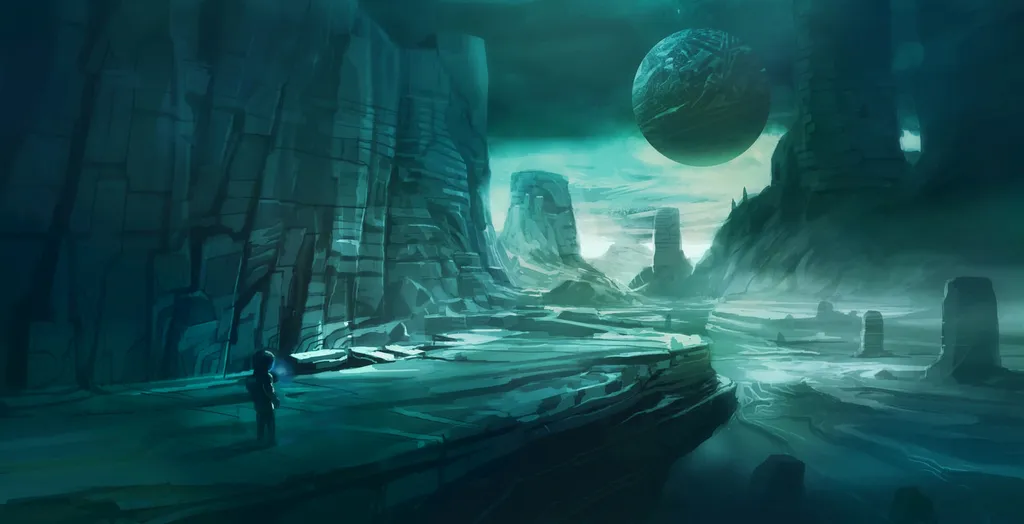Usually I wouldn’t be so hyperbolic as to label a game the very best on a headset but, let’s be honest, I can make an exception for Daydream. Outside of Google’s own apps the platform is starved of quality gaming experiences. Not only does White Elk’s Eclipse: Edge of Light answer the call for a full game on Daydream, but by the end of this memorable sci-fi adventure I was convinced it was one of the better mobile VR games in general.
You might remember Eclipse from last year when it was announced for PlayStation VR (PSVR). Since then the game’s instead been ported to Daydream. When I first heard that news I’ll admit I was a little disappointed, but White Elk has made a great case for developing full first-person adventures on the platform, even with its unusual motion controller that many people struggle to use well.
Eclipse starts off with your character crash landing on a mysterious planet after being hit by a beam of light. Within the first few minutes you discover the Artifact, a mysterious orb with various supernatural properties. With it, you can destroy rubble, guide animals, move objects and even throw it against certain surfaces to create platforms. With the Artifact in hand you set about exploring the planet, quickly discovering the remains of an ancient civilization that fell victim to a power that may involve your newfound companion.
The game’s story is organically weaved into the environment via old statues and other items that you can scan to uncover more details. It’s a little like Metroid Prime, though it uses a nifty mechanic in which you’ll scan the entire object using head-tracking. It’s a really nice Star Trek-style touch that makes you feel like you’re really there exploring this barren world, and the story evolves in a surprising way over the course of the two plus hour adventure.
When it comes to gameplay, Eclipse is surprisingly bold in its use of the Daydream remote. This is a full locomotion game where you walk forwards by holding the top of the track pad. It’s best to sit in a swivel chair for this one, as you’ll physically turn around to navigate around corners. You also have a jetpack that’s activated by holding the track pad down, which feels very responsive and liberating. If you feel like any of this would make you sick, then the game starts out with smart field of view (FOV) restrictor that can be removed.
To use the Artifact you’ll need to throw it, which is done by holding then releasing the app button as you flick your wrist. It’s a very smart way to create interactivity in VR, avoiding unconvincing actions like button presses and getting you to do something that feels natural in the virtual world.
It doesn’t work well all the time; sometimes I longed for the accuracy of an Oculus Touch or Vive wands rather than the Wii remote-like motion controls that wouldn’t let my throw the Artifact exactly where I wanted it. In fact early on in the game I outright couldn’t activate a switch as it was too close to a wall that the Artifact would be thrown to instead. The menu is also frustrating, as it’s activated by staring down at your arm for a few seconds, which is inconsistent to get working.
But with all of these mechanics in place, Eclipse leads you on a compelling few hours of exploration, with inventive puzzles and platforming along the way. I was surprised by just how easy it was to navigate long chasms with plants that would refuel my jetpack, and quick dashes between cover as turrets fired at me. Eclipse isn’t afraid to offer some memorable challenges that I’m not used to seeing in VR, like making my way through a winding labyrinth without being crushed by blocks, or gradually climbing up a wall using platforms that disappeared.
Put simply I felt like I was playing a real game, and that’s not something you can often say for VR as a whole, let alone mobile VR.
Visually the game has understandably taken a hit moving from console to mobile, but Eclipse still wowed me with its huge sense of scale and fantastic art direction. Watching doors that haven’t moved for years slowly creak, twist and turn in unusual ways brought a thrilling sense of discovery to my adventure, as did the excellent soundtrack, which does well to balance eerie sci-fi mystery with moments of sadness.
Playing on my Pixel, the game was hit by unfortunately regular stutters, especially when I played for longer and my phone got hotter. Eclipse really isn’t designed for short gameplay bursts and if you quit you might find yourself 10 minutes behind where you left your last play session, so keep that in mind when breaking to cool your phone.
If you hadn’t guessed by now I was really rather fond of Eclipse. I even see it as a sort of spiritual successor to Ustwo Games’ excellent Land’s End on Gear VR, only more ambitious. White Elk took a lot of risks with the game’s design that pay off in spades, from the smart use of Daydream’s controller to giving players full control over their movement. The result is a memorable sci-fi adventure that kept me fully engaged from start to finish, and left me feeling like I’d really explored an alien world. This isn’t just the best game on Daydream, but one of the best mobile VR games full stop.
Eclipse: Edge of Light is available from later today on Google Daydream for $8.99. Read our Game Review Guidelines for more information on how we arrived at this score.




























